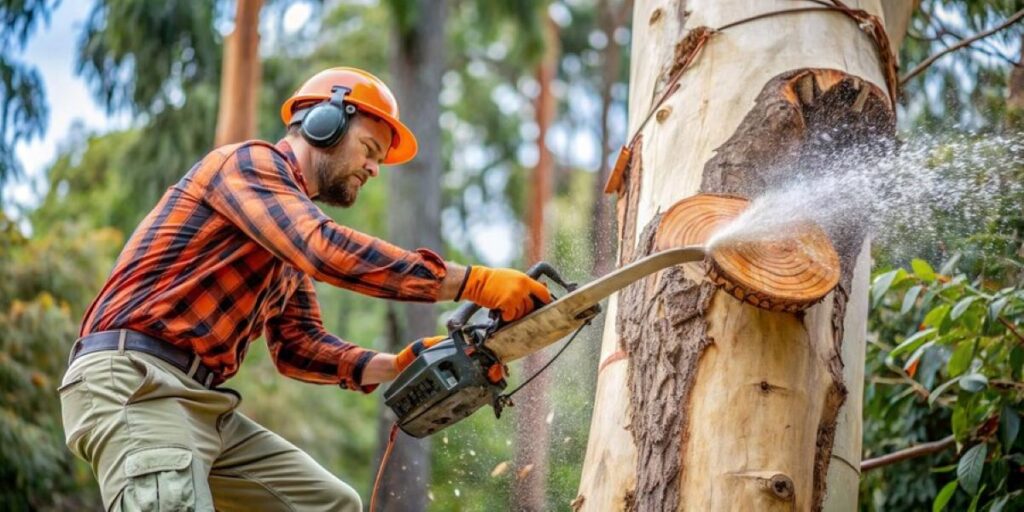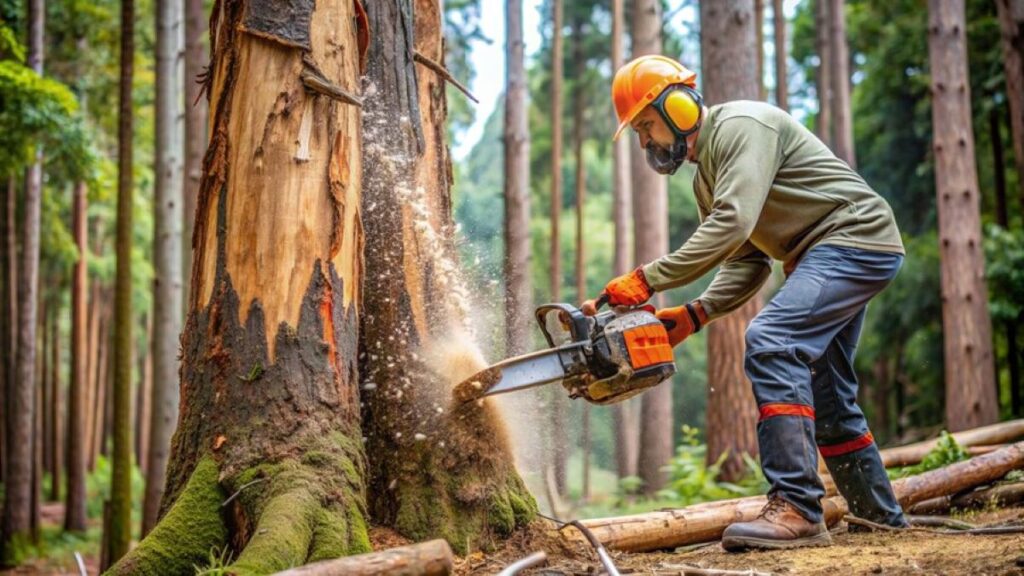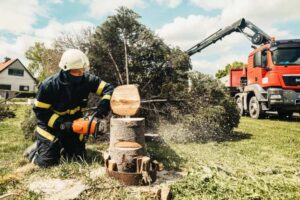Land Clearing Tree Removal: Preparing Your Site
Land clearing tree removal is a crucial first step in preparing a site for construction, landscaping, or property development. It transforms undeveloped land into a usable space while also addressing safety concerns and meeting legal requirements.
Professional tree removal service offers a wide range of activities:
- Site evaluation and planning
- Tree removal and stump extraction
- Vegetation management
- Debris disposal and recycling
- Ground preparation
The benefits of hiring professionals for land clearing tree removal go beyond just convenience:
- Safety Assurance: Certified arborists use specialised equipment and techniques to prevent accidents and property damage
- Legal Compliance: Expert knowledge of local council regulations and permit requirements
- Environmental Protection: Implementation of sustainable practices to preserve surrounding ecosystems
- Cost-Effective Solutions: Efficient project completion with appropriate equipment and expertise
- Site Optimisation: Proper preparation for future development phases
Professional land clearing services provide the expertise needed to navigate complex site preparation challenges while ensuring compliance with local regulations. The process requires careful planning, specialised equipment, and technical knowledge to achieve optimal results for any development project.
Key Aspects of Land Clearing Tree Removal
Land clearing tree removal involves several critical components that work together to ensure successful site preparation. Each aspect requires careful consideration and professional expertise.
1. Site Assessment and Planning
This involves evaluating the land’s topography, analysing the soil composition, surveying existing vegetation, mapping underground utilities, and identifying drainage patterns.
2. Tree and Stump Management
Strategic tree removal sequencing is important here, along with evaluating root systems, deciding on stump extraction methods, preventing regrowth, and protecting any vegetation that needs to be retained.
3. Equipment Selection
Choosing the right equipment is crucial. This includes determining the heavy machinery requirements, selecting specialised cutting tools, deciding on stump grinding equipment, arranging transportation vehicles, and ensuring safety gear and protective equipment are in place.
4. Debris Management Protocol
After the trees have been cleared, it’s important to manage the debris properly. This involves sorting organic materials, exploring recycling opportunities, deciding on waste disposal methods, considering on-site mulching options, and planning transportation logistics.
5. Environmental Safeguards
Throughout the process, we must also consider environmental safeguards such as erosion control measures, wildlife habitat protection, dust suppression techniques, noise reduction strategies, and water quality preservation.
6. Site Preparation Elements
Finally, we need to focus on site preparation elements like ground levelling requirements, soil compaction needs, drainage system planning, access route creation, and utility corridor designation.
Professional land clearing services integrate these aspects through systematic implementation. The process requires careful coordination of equipment, personnel, and resources while maintaining strict adherence to local regulations and environmental guidelines. Each project demands a customised approach based on specific site conditions and development objectives.
Proper execution of these key aspects ensures optimal site preparation for subsequent development phases. The success of construction projects, landscaping initiatives, or property improvements relies heavily on thorough attention to these fundamental elements during the land clearing process.
Tree and Stump Removal Techniques for Effective Site Preparation
Successful site preparation demands thorough tree and stump removal to prevent future complications. Professional arborists employ specific techniques and specialised equipment to ensure complete elimination and regrowth prevention.
Complete Removal Process:
- Deep root extraction using hydraulic equipment
- Mechanical grinding of stumps below ground level
- Chemical treatment of remaining root systems
- Soil remediation post-removal
Specialised Equipment:
- High-powered stump grinders
- Excavators with root-raking attachments
- Tree shears for controlled felling
- Root barrier installation tools
The prevention of regrowth requires targeted approaches based on tree species and site conditions. Professional arborists apply growth inhibitors to remaining root systems, ensuring long-term effectiveness. Root barrier installation creates physical boundaries, blocking potential sucker growth from neighbouring trees.
Advanced Removal Methods:
- Sectional dismantling for confined spaces
- Whole tree removal for open areas
- Stump grinding to 300mm below ground
- Root system treatment with approved herbicides
Professional stump removal services utilise powerful machinery to grind stumps to appropriate depths, allowing for future construction or landscaping. This comprehensive approach eliminates potential obstacles and ensures the site remains clear for intended development purposes.
The integration of mechanical and chemical methods creates a robust strategy for permanent tree and stump removal, establishing optimal conditions for subsequent site development phases. Check out more about Project Arborist Sydney: Managing Large Tree Projects.
Sustainable Debris Management Practices During Land Clearing Tree Removal
Responsible debris management transforms land clearing waste into valuable resources. The recycling process creates sustainable materials that benefit both the environment and future landscaping projects.
Key Recycling Applications:
1. Wood Chips and Mulch
- Protection for soil moisture retention
- Natural weed suppression
- Gradual nutrient release into soil
- Temperature regulation for plant roots
2. Composting Solutions
- Conversion of smaller branches and leaves
- Rich organic matter production
- Soil structure improvement
- Enhanced microbial activity
On-Site Material Processing
The implementation of mobile chipping equipment allows direct processing of cleared vegetation. This practice reduces transportation costs and minimises carbon emissions from multiple vehicle trips.
Sustainable Distribution Methods
Local distribution networks help allocate processed materials to:
- Community gardens
- Agricultural projects
- Landscaping companies
- Residential properties
These recycling practices align with environmental regulations while creating valuable resources for future site development. Professional arborists assess each project’s specific requirements to determine the most effective recycling strategies, ensuring maximum material utilisation and minimal waste.
The integration of sustainable debris management practices supports soil health, reduces landfill waste, and creates a circular economy within land clearing operations.

Factors Influencing Site Assessment and Preparation in Land Clearing Projects
A thorough site assessment serves as the foundation for successful land clearing projects. The site’s topography plays a critical role in determining the appropriate preparation methods and necessary equipment.
Key Topographical Considerations:
- Natural slopes and gradients
- Existing water flow patterns
- Soil composition and stability
- Natural drainage pathways
Professional grading and levelling operations transform uneven terrain into a stable, usable surface. These processes require precise calculations and specialised equipment to achieve optimal results.
Essential Grading Elements:
- Cut and fill balance calculations
- Slope stabilisation techniques
- Drainage system integration
- Soil compaction requirements
The implementation of proper drainage systems prevents water accumulation and soil erosion. Strategic grading creates subtle slopes that direct water away from structures while maintaining site stability.
Drainage Considerations:
- Surface water management
- Subsurface drainage networks
- Retention pond placement
- Erosion control measures
Site preparation must account for both immediate construction needs and long-term stability. Professional assessment identifies potential challenges and determines appropriate solutions before work begins.
Critical Assessment Factors:
- Soil bearing capacity
- Underground utilities
- Environmental protection zones
- Local council regulations
Professional arborists conduct detailed site evaluations to develop comprehensive preparation strategies that address these complex requirements while ensuring environmental protection. This involves understanding the intricate relationship between the site’s topography and its suitability for construction.
Moreover, it’s crucial to consider the impact of grading on soil stability and drainage systems during the site preparation phase. Such knowledge can significantly enhance the effectiveness of land clearing projects, ensuring they are carried out efficiently while minimizing environmental disruption.
Lastly, the long-term effects of land clearing on local ecosystems should also be taken into account, as these can influence future development plans and local biodiversity.
Minimising Environmental Impact Through Responsible Land Clearing Tree Removal Practices
Responsible land clearing practices prioritise environmental protection through strategic erosion control measures. These essential protocols safeguard surrounding ecosystems while ensuring successful project completion.
Key Erosion Control Measures:
- Installation of silt fences along property boundaries
- Strategic placement of hay bales in water flow areas
- Creation of temporary sediment basins
- Implementation of mulch barriers
The establishment of buffer zones between clearing areas and sensitive ecosystems helps maintain natural habitats. These designated spaces act as protective barriers, filtering runoff and preserving local wildlife corridors.
Environmental Protection Protocols:
- Soil stabilisation through hydroseeding
- Preservation of native vegetation where possible
- Installation of erosion control blankets
- Regular monitoring of water quality
Professional arborists conduct thorough site assessments to identify vulnerable areas requiring additional protection. This proactive approach includes:
- Mapping of water courses
- Identification of protected species
- Assessment of soil stability
- Documentation of existing vegetation
The implementation of these measures requires specialised equipment and expertise. Certified arborists utilise advanced techniques to minimise soil disturbance and protect root systems of retained vegetation. This comprehensive approach ensures sustainable land clearing practices while maintaining ecological balance.
Choosing the Right Equipment and Techniques for Efficient Land Clearing Tree Removal
The selection of appropriate equipment and techniques plays a vital role in successful land clearing operations. Different project scales demand specific approaches to achieve optimal results.
Large-Scale Projects
- Heavy machinery such as bulldozers and excavators
- Mechanical tree shears for rapid removal
- Forestry mulchers for efficient vegetation processing
- Track-mounted equipment for challenging terrain
Small to Medium Projects
- Compact skid steers with attachments
- Portable stump grinders
- Chainsaws and manual tools
- Mini excavators for precise work
Specialised Equipment Benefits
- Reduced labour requirements
- Increased safety measures
- Enhanced project efficiency
- Minimal ground disturbance
The choice between mechanical clearing methods and manual techniques depends on:
- Site accessibility
- Environmental sensitivity
- Project timeline requirements
- Budget constraints
- Terrain characteristics
- Vegetation density
Professional arborists assess these factors to determine the most effective combination of equipment and techniques. Advanced machinery equipped with GPS technology enables precise clearing while preserving designated trees and vegetation. Specialised attachments allow for selective removal, maintaining soil stability and reducing environmental impact.
Modern equipment features enhanced safety mechanisms and improved fuel efficiency, contributing to both worker protection and reduced environmental footprint. The integration of hydraulic systems provides better control during delicate operations near structures or utilities.

Ensuring Proper Utility Installation and Access Road Construction After Land Clearing Tree Removal
The successful completion of land clearing tree removal opens opportunities for essential infrastructure development. Access roads serve as critical arteries for construction vehicles, maintenance teams, and future property access.
Key Components of Access Road Construction:
- Proper grading to ensure stable road foundation
- Strategic placement for optimal site accessibility
- Adequate width to accommodate various vehicle types
- Appropriate drainage systems integration
Utility Installation Considerations:
- Underground utility mapping
- Safe distances between utility lines
- Proper depth requirements
- Soil compaction specifications
Professional coordination with utility companies becomes essential during post-clearing activities. This collaboration helps:
- Identify existing underground services
- Plan new utility corridors
- Establish connection points
- Meet safety regulations
- Schedule installation timelines
The creation of well-designed access roads supports:
- Emergency vehicle access
- Construction equipment movement
- Regular maintenance activities
- Future site development needs
Professional arborists work closely with utility providers to ensure compliance with local regulations while maintaining site safety. This integrated approach protects both infrastructure investments and enables efficient site development progress.
The establishment of proper access routes paired with strategic utility placement creates a foundation for successful property development. These elements work together to support long-term site functionality and value.
Conclusion
Professional land clearing tree removal services are essential for successful site preparation. The complexities of tree removal, environmental considerations, and regulatory compliance require expert knowledge and specialised equipment.
Key benefits of professional services include:
- Guaranteed safety protocols and risk management
- Efficient project completion within specified timeframes
- Proper handling of utilities and infrastructure requirements
- Environmental protection and sustainable practices
- Full compliance with local council regulations
Investing in professional land clearing services is invaluable for both immediate project success and long-term site stability. Certified arborists bring decades of experience, comprehensive insurance coverage, and advanced equipment to ensure optimal results.
Proper site preparation through professional land clearing tree removal creates a solid foundation for future development while preserving surrounding ecosystems. This essential groundwork protects property value and minimises potential complications during subsequent construction phases.

